Hybrid War and Hybrid Peace on the Black Sea. The Parallel Realities

The Monitoring Group of the BlackSeaNews and
the Black Sea Institute for Strategic Studies
Based on the results of our own monitoring, the Monitoring Group of the BlackSeaNews and Black Sea Institute for Strategic Studies presents the analytical report Hybrid War and Hybrid Peace on the Black Sea. The Parallel Realities.
* * *
Both the Ukrainian and foreign readers are, of course, well aware of one of the biggest surprises of this war — namely, the defeat of the Russian Black Sea Fleet (BSF), that as a result, has been forced to largely abandon its historic main base in the occupied Sevastopol. That case is now, certainly, being closely studied by all the general staffs and military academies of the world.
But the uniqueness of the current situation is that simultaneously with the actual hot war in the Black Sea, we also see certain "hybrid" processes, so to speak, that while seemingly unrelated to the war, occur in parallel to it.
* * *
If we manage to completely tune out Ukrainian missile and drone attacks on the BSF and Crimean ports, Kerch ferry crossing and Russian Black and Azov coast oil refineries, as well as Russian missile and drone attacks on Ukraine from Crimea and Russian coastal regions — in particular, on the port infrastructure of the Black Sea Odesa region and the Danube — in other areas, it may seem, there is basically no war, since we see almost normal maritime traffic there.
Admittedly, that “tuning out” wouldn’t сome easy, considering that in January-June 2024, for instance, the Russian army used the occupied Crimea to strike at the regions of Ukraine with no less than:
- 38 Kalibr sea-launched cruise missiles from the BSF surface ships and submarines
- 69 Iskander-M ballistic missiles
- 1 P-800 Onyx anti-ship missile
- 3 3M22 Zircon hypersonic missiles and
- 977 Shahed-136/131 strike UAVs launched from both Crimea and Russian regions combined
At the same time, first of all, for almost a year now, since mid-August 2023, cautiously at first, and in full force since mid-September, the Ukrainian sea corridor has been operating not only from the Danube ports, as before, but also to/from the ports of Greater Odesa — Chornomorsk, Odesa, and Yuzhny — at what’s estimated to be the 2021 level. That is a separate extraordinary development in itself, that doesn’t seem to be a military one, but that without our military, would not have been possible.
Before the war, Ukraine's seaports accounted for about 60% of all domestic exports and 40% of imports. At present, we can only talk about exports, since only that data is partially available. Understandably, at the time of war, there are no public numbers for imports.
Speaking of that, we certainly can’t avoid feeling the glaring absence in the Ukrainian economy of the now occupied Mykolaiv and Kherson ports. That’s just yet another daily reminder of the war.
As of February 24, 2022, the beginning of the Great War, there were exactly 100 commercial vessels in Ukraine's Black and Azov Seas ports.
* Blocked ships in Ukrainian ports during the war: The Berdiansk port
* Blocked ships in Ukrainian ports during the war: The port of Mariupol
* Ships blocked in Ukrainian ports during the war: The ports of the Mykolaiv region
* Blocked ships in Ukrainian ports during the war: The port of Kherson
* Blocked ships in Ukrainian ports during the war: the Pivdenny commercial sea port
* Blocked ships in Ukrainian ports during the war: The Odesa commercial sea port
* Blocked ships in Ukrainian ports during the war: The commercial sea port of Chornomorsk
* As of September 26, 2022, 60 of 100 vessels remain blocked in the ports of Ukraine/ Databas
As of the end of last year, after some of the blocked vessels had been able to leave Odesa ports through the corridor created with the UN assistance, 50 of them remained.
Of those, 29 were in the ports of the Mykolaiv Oblast, 14 in Kherson, and 5 in Mariupol. Only two remained in Odesa ports, one of which was arrested due to its Russian owner. Most of the remaining vessels belong to Greek and Turkish owners.
Of those blocked in Mykolaiv ports, based on the shipowners registration, seven ships are Turkish, eight Greek, two each from Norway and China, 1 each from Estonia, Denmark, Singapore and the United Kingdom. Those are large seagoing vessels that had come for cargo before the full-scale invasion, but got stuck and still can’t leave. With the ships remaining in the ports of occupied Mariupol, the situation is still clearly hopeless. But there should be no illusions about those blocked in the ports of the Ukraine-controlled territory either: until the southern part of the Kherson region is de-occupied, they will remain blocked.
* The fate of the ships that were in the ports of Ukraine on 24 February 2022: The updated databas
 Almost every day we read about the shelling of Ochakiv and the adjacent waters. There are active hostilities there. To unblock it, we need to liberate Crimea and, of course, the occupied part of Kherson Oblast.
Almost every day we read about the shelling of Ochakiv and the adjacent waters. There are active hostilities there. To unblock it, we need to liberate Crimea and, of course, the occupied part of Kherson Oblast.
In addition, we have no clear understanding of what happened to the ships that remained in Kherson Oblast after the flood, as a result of Russia blowing up of the Kakhovka hydroelectric power station on June 6, 2023. It is possible that a significant number of those vessels have been lost or need to be repaired.
Secondly, during all this time, there has been no change to the huge undisturbed Russian maritime traffic from the Black and Azov Seas ports, that facilitates one of the most fundamental export bases of the Russian economy, mainly of crude oil, oil products, grain, coal, sulfur, fertilizers, etc., totaling tens of millions of tons.
To that, we should also add a considerable and, alas, also undisturbed maritime traffic from the ports of the occupied Crimea — mainly, Russia's covert export of stolen Ukrainian grain from the occupied southern Ukraine, that is, from parts of Zaporizhzhia and Kherson regions, as well as from the Crimean peninsula itself, amounting to over 1 million tons per year.
Third, the maritime activity of our Black Sea neighbors also continues as usual. Underwater gas pipelines from Russia to Turkey — the Blue and Turkish Streams — remain operational. There is also natural gas exploration and production in the Romanian and Turkish offshore fields, as well as traditional shipment to and from Romanian, Bulgarian, Turkish and Georgian ports. To them, the only occasional reminders of the ongoing war in and over the sea come in the form of sea mines and drones washed ashore on those countries’ coasts, as well as Russian drones that occasionally fly into Romania and Moldova.
Having said that, despite business as usual, for our maritime neighbors, the war has nevertheless brought some new focus, circumstances, and multi-vector changes.
- For example, while Romania has significantly increased its port capacities for the transit of Ukrainian grain,
- Turkey has significantly increased its Russian oil and oil products imports not only from the Black, but also from the Baltic Sea, for further processing and re-export to Europe and Africa.
- We also see now something akin to the start of the Russian oil products re-export operations happening via Georgian ports.
- Finally, a decent-size Moldovan-owned tanker fleet for the transportation of Russian oil has also suddenly appeared on the horizon.
* * *
 In these circumstances, it’s not appropriate to compare Ukrainian maritime business’s current and pre-war performance. With regard to Ukraine and its maritime industry, we must understand that it’s one thing to discuss peacetime maritime trade and port operations happening before February 26, 2014, i.e. before the occupation of Crimea, and another — after the Ukrainian economy lost not only the Crimean ports, but also, all its huge maritime cruise business, where Ukraine had been the undisputed Black Sea leader in the number of cruise ships received.
In these circumstances, it’s not appropriate to compare Ukrainian maritime business’s current and pre-war performance. With regard to Ukraine and its maritime industry, we must understand that it’s one thing to discuss peacetime maritime trade and port operations happening before February 26, 2014, i.e. before the occupation of Crimea, and another — after the Ukrainian economy lost not only the Crimean ports, but also, all its huge maritime cruise business, where Ukraine had been the undisputed Black Sea leader in the number of cruise ships received.
According to the 2013 cruise navigation results, Ukraine's seaports received 293 cruise ships, which was 98 ship calls more than the previous year. Odessa seaport received 106 cruise liners with 81,367 passengers, Yalta seaport - 109 cruise liners with 77,880 passengers, Sevastopol seaport - 58 liners with 23,400 passengers, Feodosia seaport - 18 liners with 3,479 passengers, while Yevpatoria and Kerch - one liner each. In total, 186,496 foreign passengers arrived at Ukrainian ports on cruise ships, or 54,825 more than in 2012.
Over 2009-2013, the number of ship calls to Ukrainian ports increased by 40%, while the number of passengers - by 53.4%. The Black Sea region was most often visited by tourists from Germany (23.2%), Great Britain (17.7%) and Italy (12.4%). The share of cruise tourists from CIS countries to Ukrainian ports was 1%, and even less than that in 2012.
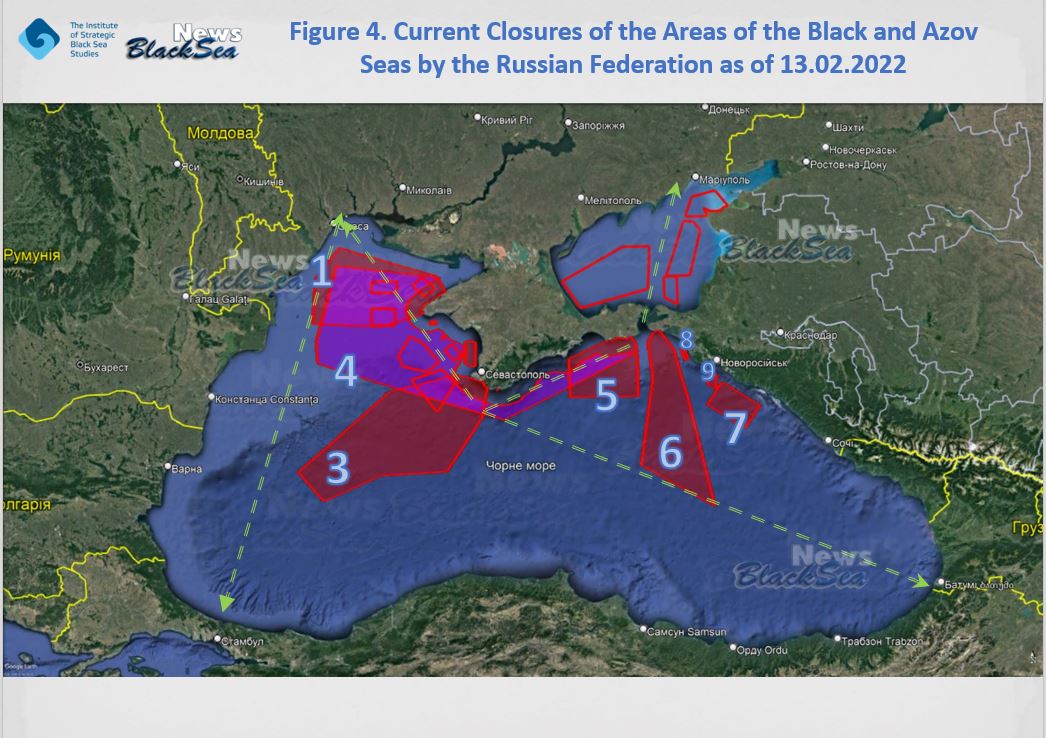
* A «Russian Lake»: the Nine Aspects of the Current Situation in the Black Sea
* A «Russian Lake»: the Nine Aspects of the Current Situation in the Black Se
It was at that time that Russia radically renewed its BSF combat capacity by replenishing it with 13 ships and submarines with Kalibr missiles, dozens of aircraft and modern coastal missile systems, such as Bal, Bastion and Iskander, now stationed on the occupied peninsula.
* The Militarization of Crimea as a Pan-European Threat and NATO Response. Third Edition
* Security Risks in the Black Sea and the Sea of Azov in 202
And it was then that it declared a huge part of our sea “Russian” and began regular naval exercises with missile firings and large-scale blockades of sea areas to prevent Ukrainian ports operation.
* Closure of the Azov-Black Sea Region in November-December 2021
* Increased Risks. Obstruction of Traffic in the Black and Azov Seas by Russia due to the Closure of Sea Areas for Military Exercises as of 15 February 202
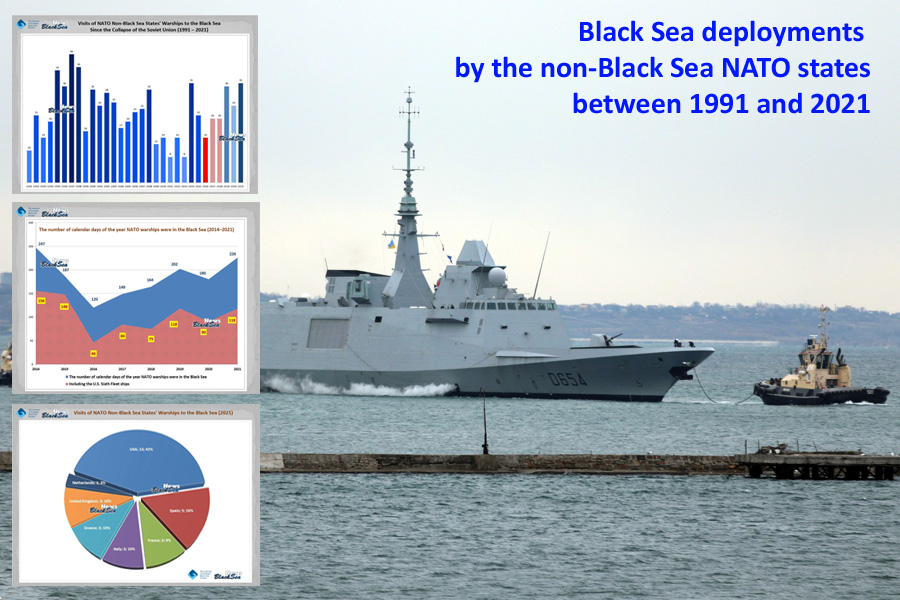 Incidentally, even though ironically, NATO Maritime Command and the US 6th Fleet, that each year since 2014 had been consistently ensuring not just high, but unprecedented, level of the non-Black Sea NATO states warships’ presence in the Black Sea to guarantee freedom of navigation, suddenly stopped those deterrence operations on January 3, 2022, a month and a half before Russia's large-scale invasion of Ukraine. That has left the Black Sea completely at Russia's disposal due to the West’s now customary fear of "escalation".
Incidentally, even though ironically, NATO Maritime Command and the US 6th Fleet, that each year since 2014 had been consistently ensuring not just high, but unprecedented, level of the non-Black Sea NATO states warships’ presence in the Black Sea to guarantee freedom of navigation, suddenly stopped those deterrence operations on January 3, 2022, a month and a half before Russia's large-scale invasion of Ukraine. That has left the Black Sea completely at Russia's disposal due to the West’s now customary fear of "escalation".
* The 2021-January 2022 presence of non-Black Sea NATO states’ warships in the Black Se
The next stage, from February 24, 2022, to July 2023, was marked by our mainland Ukraine seaports being completely blocked, with only those on the Danube left operating.
It was then followed by the UN grain corridor, Ukraine's emergency efforts to develop the Danube ports, and
finally the current period, since August 2023, when the Ukrainian sea corridor became functional.
For commercial shipping, all of that can be only described as marine wartime economy, i.e., when you have war at sea, in the air over it, and across the radio waves.
Under such conditions, many of the maritime transportation and port business mechanisms that had worked in Ukraine before and continue to work in countries untouched by hostilities, can’t possibly work here now. Not to mention, that the key players have also changed, and so should the criteria for the performance evaluation.
Gone are the times what it was the Russian Navy that was the main player on the Black Sea, including in port business. Now it’s the Ukrainian Navy and, broadly speaking, the Ukrainian Defense Forces, that run the show.
That is, the Navy, Air Force, the Joint Forces coastal defense group, and special services — the Security Service of Ukraine, the Defense Intelligence Agency, etc. They are the ones who primarily determine how our maritime traffic in the Black Sea operates.
Today, ships enter and leave Ukrainian seaports only when they are authorized to do so by our military in accordance with its own safety criteria for ships and crews, and only along the routes chosen not due to their economic efficiency, but exclusively to their military expediency. The latter boils down to the army’s ability to guarantee the ships and crews an acceptable level of protection from such threats as running into a sea mine or being attacked from the sea or air.
Hence, the traditional economic approaches to assessing port performance are senseless now. However, journalists traditionally writing about ports, as well as economic experts and officials, keep trying to compare the current indicators with the peacetime ones. Truth is, though, it’s time for completely different indicators.
For instance, in the media, we see comparisons with the 2021 cargo volume transported for export through the Ukrainian sea corridor. But there is a reason why the data given is reported by just one state body — the port administration — and not by a whole bunch of both state and non-state sources, as was the case before the war. And note, dozens of indicators, that state source now reports just one — the total volume of export transportation, with a clause simply phrased as "including agricultural products." While being an absolutely sufficient information dose for wartime, it certainly, isn’t for the traditional market analysis.
 I am convinced that what is important today is the very fact that for many months, almost a year now, we have become accustomed to seeing our western part of the Black Sea and ports being actively used for civilian shipping.
I am convinced that what is important today is the very fact that for many months, almost a year now, we have become accustomed to seeing our western part of the Black Sea and ports being actively used for civilian shipping.
Here is an indicator that we have been monitoring every day for many months: since the beginning of this year, more than 200 vessels have called at the three ports of Greater Odesa each month, averaging seven-nine vessels per day.
For comparison, when the maritime export corridor was operating under the UN auspices with the participation of Turkey and Russia, in the first month of its operation, an average of six ships called at Odesa seaports daily, which soon turned into five, three, one and a half, and finally, zero. On average, during the year of the UN corridor operation, there were about three ships per day entering the three ports, or one ship per port daily.
* The operations of the Ukrainian temporary maritime export corridor from the ports of Greater Odesa (the database as of 16/10/2023)
* The grain corridor in the Black Sea in June – July 2023: The final statistics and databas
But how great is it now to sometimes see almost the entire berthing front in all three Odesa ports packed with ships. Naturally, the port workers are even happier than us, and so is Ukraine’s state budget. In other words, the Ukrainian corridor is on average three times more efficient than the UN one.
I'd like to once again emphasize that in the situation where every ship’s voyage is in fact, a successful military operation, it is the number of ships that matters, not their deadweight (cargo capacity) or any other parameters.
* * *
A huge role in the success of the Ukrainian sea corridor has been played by the combined operations of the Ukrainian Defense Forces that have effectively made the Western part of the Black Sea off-limits to Russian surface ships due to the risk of being hit and sunk.
That accomplishment has a fairly long history by now, that includes the liberation of Zmeinyi Island, the destruction of Russian surveillance equipment, helipads and mini-garrisons on those same offshore gas platforms in the northwestern part of the sea, and last but not least, the massive destruction of the BSF ships.
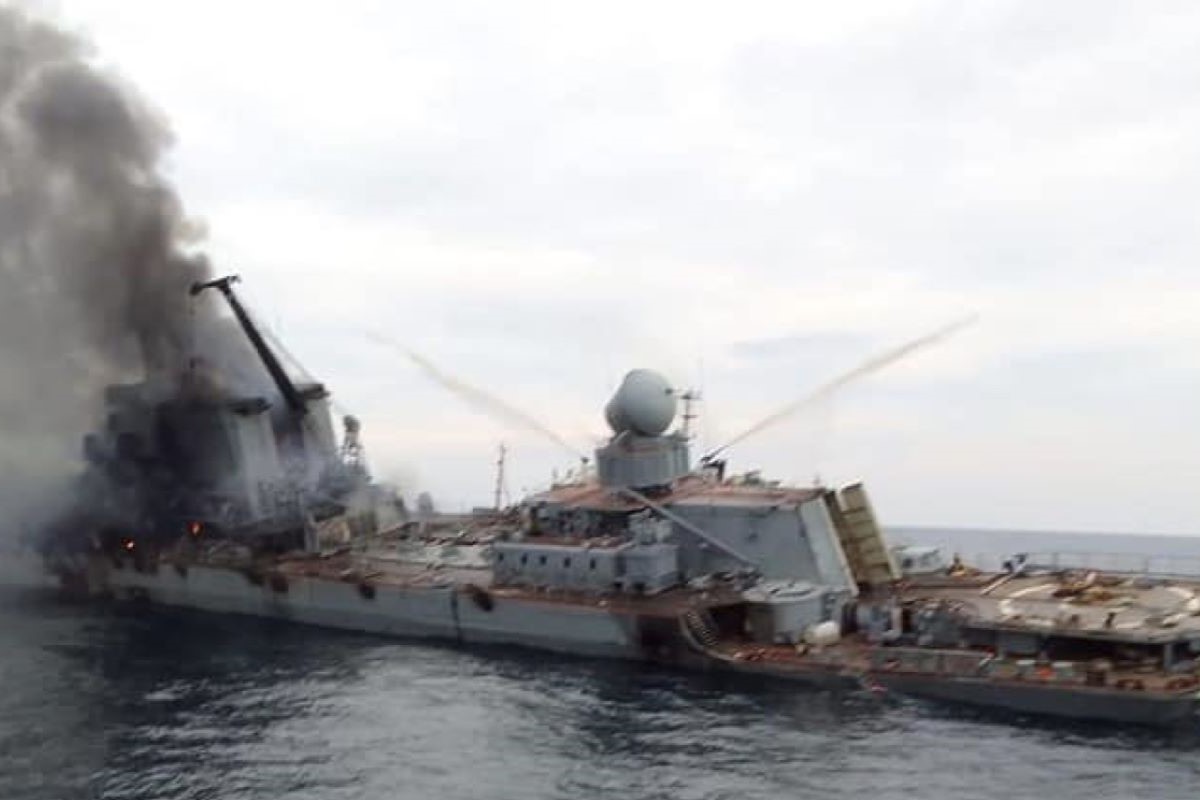 Let’s not forget that the Ukrainian Navy's strikes on enemy forces at sea — on April 5, 2022, project 11356R missile frigate Admiral Essen damaged by a Ukrainian Neptune anti-ship missile (ASM) in the NW of the Black Sea; on April 14, 2022, project 1164 missile cruiser Moscow destroyed by two Neptune ASMs, and on June 17, 2022, the BSF project 22870 rescue and towing vessel Spasatel Vasyl Bekh destroyed by two Harpoon air defense systems the near Zmeinyi Island — disrupted the enemy's domination in the northwestern part of the sea, making any of its active operation there impossible, as well as the enemy's logistics with Zmeinyi Island. As a result, the new conditions allowed for the resumption of our navigation and the liberation of the island, or as Russia called it, its ”voluntary abandonment" by Russian troops.
Let’s not forget that the Ukrainian Navy's strikes on enemy forces at sea — on April 5, 2022, project 11356R missile frigate Admiral Essen damaged by a Ukrainian Neptune anti-ship missile (ASM) in the NW of the Black Sea; on April 14, 2022, project 1164 missile cruiser Moscow destroyed by two Neptune ASMs, and on June 17, 2022, the BSF project 22870 rescue and towing vessel Spasatel Vasyl Bekh destroyed by two Harpoon air defense systems the near Zmeinyi Island — disrupted the enemy's domination in the northwestern part of the sea, making any of its active operation there impossible, as well as the enemy's logistics with Zmeinyi Island. As a result, the new conditions allowed for the resumption of our navigation and the liberation of the island, or as Russia called it, its ”voluntary abandonment" by Russian troops.
Below are the numbers our monitoring has yielded. Since February 22, 2022, the AFU have carried out at least 43 effective attacks on Russian warships in the Azov and Black Seas — both in ports and on the high seas — with the use of missiles, small unmanned boats, UAVs, and sea mines.
As a result, the Russian fleet in the Black Sea suffered the following losses:
• 22 ships and boats destroyed, excluding those damaged beyond repair
• 21 ships and boats damaged, including those beyond repair
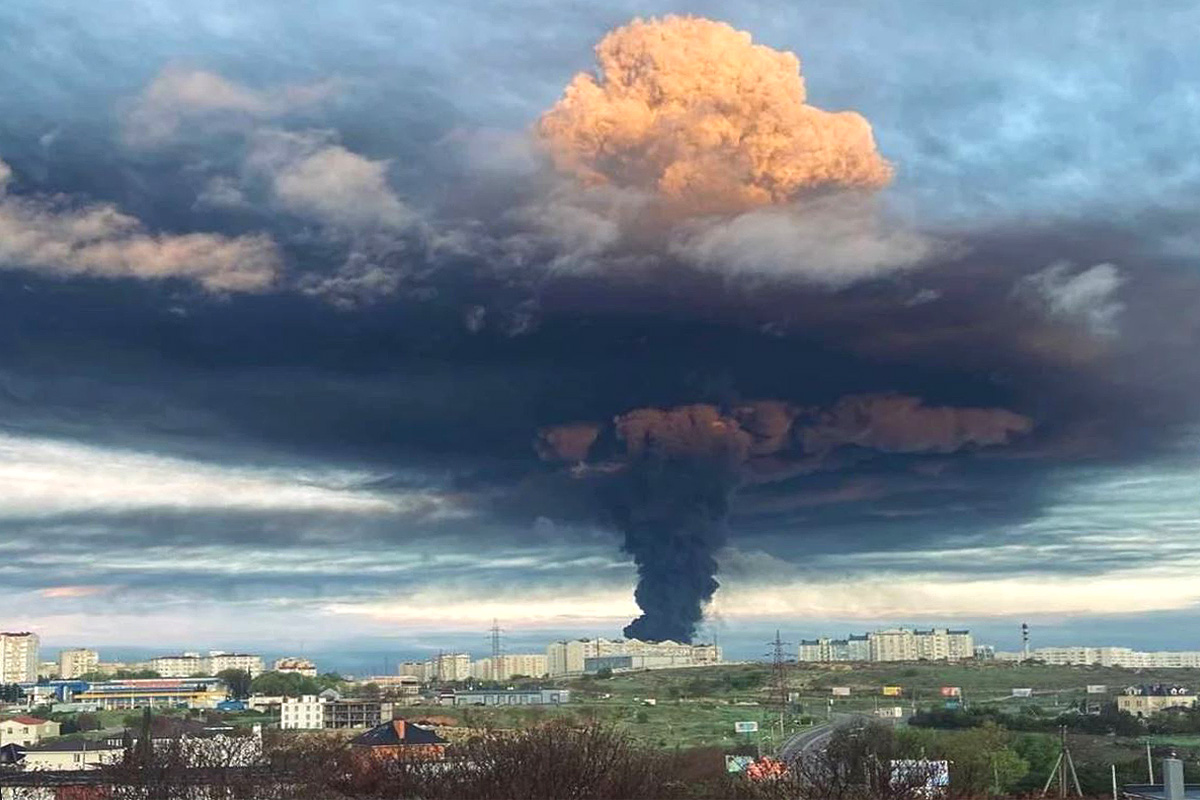
* A database of attacks by Ukrainian drones and missiles on the territory of occupied Crimea and Russian ships in the Black Sea in January-December 2023
* Database of Ukrainian Attacks on the Occupied Crimea, Russian Ships and Facilities on the Black Sea Coast in January-May 202
As a result, the Russian Navy and other armed forces units either don’t have the technical capability for or are reluctant to risk actually interfering with our maritime traffic. That’s the status quo for now.
But I want to stress the “for now” part.
We shouldn’t assume that the enemy has no further plans. There can be no doubt they do, since they certainly realize that our maritime exports, that are currently even growing, mean more resources in the Ukrainian budget for continuing repelling Russia. And once again, conversely, Russian maritime exports discussed above, keeps generating cash flow that funds the war against us, and in significant numbers, totaling billions of dollars.
Every month Russia exports from 4 to 6 million tons of crude oil and about the same amount of oil products from the Black Sea ports.
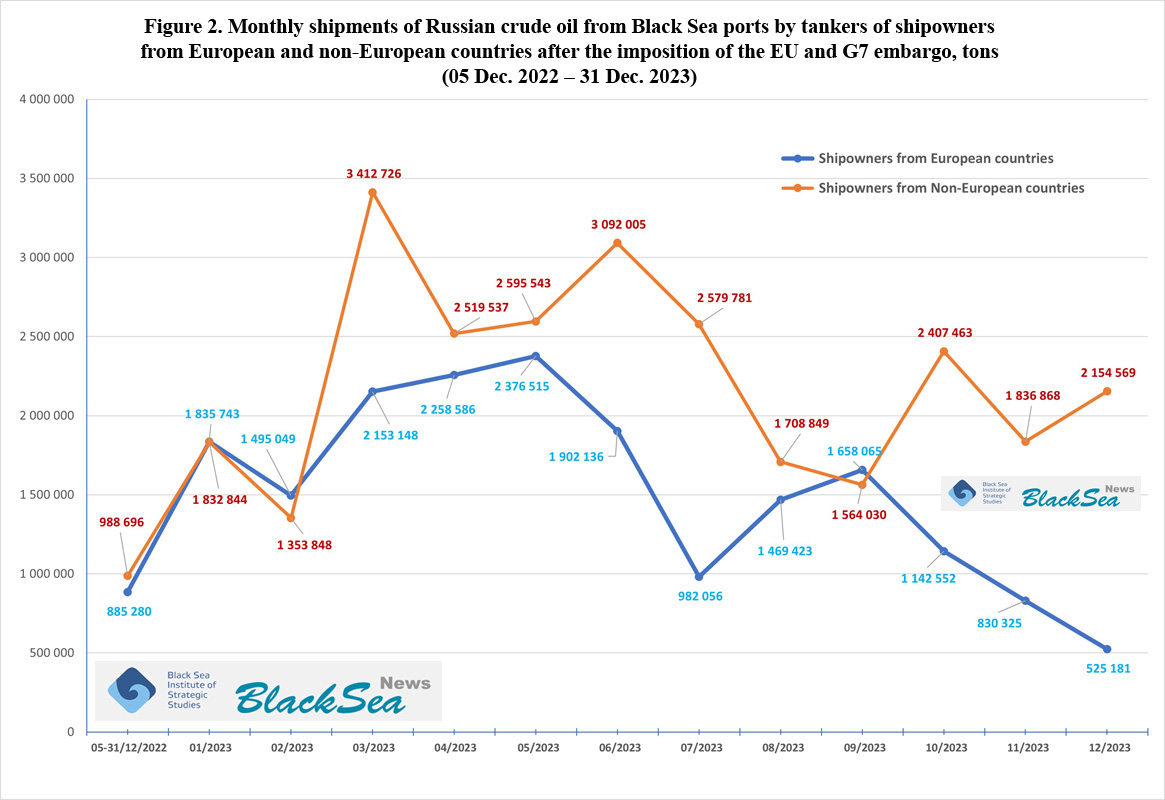 So, for the year, since July 2023, the total volume of oil exports amounted to about 42.9 million tons of crude oil and 43.6 million tons of oil products. Measured physically, in tankers, it equals 30-32 huge crude oil tankers and 140 oil product tankers monthly. That is Russian raw materials that are under sanctions in the West. Then there are another 45-50 large tankers a month with Kazakh oil, that is not under sanctions, but that Russia also gets its share from — all in all, about 220 tankers a month.
So, for the year, since July 2023, the total volume of oil exports amounted to about 42.9 million tons of crude oil and 43.6 million tons of oil products. Measured physically, in tankers, it equals 30-32 huge crude oil tankers and 140 oil product tankers monthly. That is Russian raw materials that are under sanctions in the West. Then there are another 45-50 large tankers a month with Kazakh oil, that is not under sanctions, but that Russia also gets its share from — all in all, about 220 tankers a month.
Exports of Russian Crude Oil from Black Sea Seaports Over the Period of the EU/G7 Embargo — December 5, 2022 - December 31, 2023 (1)
Who transported Russian crude oil from Black Sea ports after the EU and G7 embargo was imposed (2)
Where Russian Crude Oil in the Black Sea Was Transported From During the EU and G7 Embargo (3)Where Russian Crude Oil was Transported from the Black Sea during the EU and G7 Embargo (4)
So, even without Kazakh oil, the very roughly estimated cash flow comes to about $50 billion a year. And that’s only oil and oil products, not including other Russian exports.
By comparison, 60 million tons of Ukrainian grain over the same period yield a cash flow of $12-15 billion a year.
Add to that Russia’s oil and oil product exports from the Baltic ports, that continue undisturbed. From there, Russia exports even more oil — about 11 million tons monthly, plus another 3.5 million tons of oil products.
Therefore, until the international community finds mechanisms to stop Russian maritime oil exports, the war will continue. Until those numbers fall at least twofold or threefold, Russia will have enough financial resources to continue the war.
Overall, what’s happening right now may be referred to as a parallel economic war at sea. So far, despite the seething emotions upon seeing hundreds of ships calmly leaving your enemy’s ports, which generates billions of dollars in revenue, the warring parties have not yet been openly attacking each other’s civilian vessels.
Speaking of that, in July 2023, right after Russia's unilateral withdrawal from the UN grain corridor, the Russian Ministry of Defense declared every ship sailing to Ukrainian ports being now a "legitimate military target," to which on the following day, the Ukrainian Ministry of Defense responded in kind.
* * *
The biggest constraint for Ukrainian Black Sea navigation is the lack of the sufficient number of air defense systems. Greater Odesa is a large region, and if you also take in account the expansive infrastructure of several Danube ports located there, it becomes clear that one Patriot battery isn’t enough.
We need several divisions of modern air defense systems of various types and characteristics. That is, the air defense of ports must be very powerful. Until then, we can certainly keep wasting our breath discussing freight rates, loading speeds, berthing times, etc. In truth, the main factor is the level of protection against air strikes.
Despite the risks, however, I’d like to suggest another criterion for our current port operation besides the simple increase in the number of vessels calling at the ports of Greater Odesa — namely, the number of those ships’ repeat calls there. Those make about 65-70% of the total number of vessels.
Some of them have already called there for the fifth or seventh time, while others have done that 10 or 12 times. What does it tell us? Obviously, that shipowners rate the security level quite highly — otherwise, they wouldn’t have risked their ships, costing millions, and the lives of their crew members.
At present, 25-30% of vessels calling at the ports of Greater Odesa are owned by Greek and Turkish shipowners, respectively. That’s half of all the vessels. In general, shipowners from more than 25 countries are now present in the Black Sea ports. There are also Ukrainian-owned ones there, but relatively few. Another interesting fact to note -— about 5% of the ships calling at Odesa ports belong to Chinese.
Clearly, that serves as an additional protection. After all, Russia can’t help but realize that if their missile hits a Turkish ship docking or in crossing, they would face a harsh talk with Turkey’s President Erdogan. It seems that Russia isn’t eager to have such a conversation with China’s leader Xi Jinping either.
Russia openly claims that Ukraine is importing weapons to Odesa ports by sea and that is how they justify their ballistic missile attacks on port infrastructure. And that's why they consistently, even though unsuccessfully, use their friends in Turkey to periodically throw in messages lobbying restoration of the "UN corridor" that entails cargo control.
Last year, a missile hit a bulk carrier in the Pivdennyi port, sadly, killing the Ukrainian pilot and injuring two foreign crew members. But it doesn’t appear to have been a targeted attack. It was a small, anti-radar missile and according to one version, it might have simply automatically guided itself towards the ship, reacting to its radar. As far as I understand, for that very reason, they advise ships to turn off radars in Ukrainian ports.
There was also a strange explosion on a ship about to enter one of the Danube mouths, but no further information followed. So, in summary, we have two incidents per year per about 2,500 thousand vessels. That’s not a lot, although in each of the cases, one can’t help but sympathize with the injured sailors.
Unlike ships in Odessa ports, the port infrastructure has definitely sustained a serious damage. Ukrainian business is trying to cope with it as quickly as possible — what can be restored is being restored. We need to take off our hats to the Ukrainian maritime business and all its work, as well as for its optimistic, stubborn and patriotic character.
Overall, those Russian strikes won’t be able to disrupt the entire infrastructure of Odesa ports, especially the Danube ones Since last year, the Danube has had port infrastructure wherever there is a shore and access to water.
Russian missiles can destroy a single warehouse or terminal, or even several of them, but they cannot destroy the entire port infrastructure. The facilities are too large and very extensive. There will be business losses and, unfortunately, human losses until, as we mentioned above, we cover everything with reliable air defense.
* Database of Russian Missile and UAV Attacks on Ukrainian Regions from the Occupied Crimea in January-December 2023
* Database of Ukrainian Attacks on the Occupied Crimea, Russian Ships and Facilities on the Black Sea Coast in January-May 202
More serious than the missile threat nowadays, though, is mine danger in the Black Sea.
It’s a well known fact that before the start of the Great War, several thousand mines had been placed there both by Ukrainians in front of our ports, and also, by the Russians to hamper our sea traffic. Naturally, after all this time, the mines are being blown up and carried into the sea. And that opens up a window of opportunity for Russian insinuations and false flag sabotage, which are truly the Russian trademarks.
For example, if a mine they secretly plant damages a merchant ship, they will start claiming that it was a Ukrainian mine. So we see that as the main danger in the short term.
For that reason, last spring at the Black Sea Security Forum in Bucharest, Ukrainian experts proposed creating a Black Sea minesweeping group with the participation of Turkey, Romania, and Bulgaria.
Ukraine has been persistently promoting that idea, and a few months ago, it was finally put into practice. For a year and a half, at the state military and diplomatic levels, Ukraine has been pushing for the three countries, all of whom are NATO members, to accomplish that. And they have, but only after dozens of mines had washed up on their coasts, including Turkey's. You see, the problem is that while we in Ukraine live and work in wartime conditions, other countries continue to function within the peacetime mindset that is difficult for them to get out of.
The task now is to ensure that the minesweeping group operates not only in the 12-mile territorial sea zone of Turkey, Bulgaria and Romania, but also beyond it.
Clearly, the operation of Ukrainian ports is heavily affected by the current frequent and prolonged blackouts, but even more so by the air raids. When they are announced, all loading and unloading operations stop and employees must proceed to the shelters, which obviously, slows down the work pace.
Ukrainian ports on the Danube deserve a special mention. What the Danube ports and those responsible demonstrated last year is without an exaggeration, an act of heroism. The rise of transshipment figures by almost six times is definitely a feat. To make it possible, many people, both in government and business, have put forth an extraordinary effort. They took the steps and did the difficult things that everyone had long known were necessary, but that in peacetime nobody got round to.
I repeat, a sixfold increase in transshipment is a feat. In order to make it possible, a lot of people had to fulfill rather complicated tasks, including, foremost, deepening the Danube's fairways. For the entire time of their existence in independent Ukraine, the Danube ports had not seen ships of the size that called there in 2023. A huge amount of work has been done by both Ukrainian and Romanian government agencies. The number of pilots, without whom it would’ve been impossible to pass the Danube mouths, has increased several times. And previously, there hadn’t been that many of them in general. Before the Ukrainian maritime corridor, Ukrainian Danube ports, together with Romanian ports, had literally saved Ukrainian exports.
Certainly, compared to Odesa ports, logistically that is a less convenient route. And we are seeing that this year, quite naturally, many vessels that used to operate on the Danube are now focusing on the Black Sea ports. So, our Danube ports will see a decline in numbers, but those may still be higher than the pre-invasion ones. Of course, there will be no record volumes. However, the Danube should not be underestimated. When you are shelled by the enemy every day, having a backup route is crucial.
Needless to say, that backup route needs to be well maintained in terms of hydrography, navigation, and infrastructure.
* * *
So, the line between the "hybrid war" and the "hybrid peace" in the Black Sea is indeed a very tentative one and can be deliberately or accidentally crossed at any moment. And that is the reality of our truly "hybrid times," that both the Ukrainian military and the Ukrainian maritime business have been continuously operating in on the way to our victory.
* * *
 This article has been prepared with the support of the European Union in Ukraine. The content of the article is the sole responsibility of the authors and does not necessarily reflect the position of the EU
This article has been prepared with the support of the European Union in Ukraine. The content of the article is the sole responsibility of the authors and does not necessarily reflect the position of the EU
More on the topic
- 07.11.2023 A database of attacks by Ukrainian drones and missiles on the territory of occupied Crimea and Russian ships in the Black Sea in January-October 2023
- 03.10.2023 Russia's use of the territory of occupied Crimea for aggression against Ukraine and creating a threat to the countries of the region in 2023
- 27.09.2023 The fate of the ships that were in the ports of Ukraine on 24 February 2022: The updated database
- 28.09.2022 As of September 26, 2022, 60 of 100 vessels remain blocked in the ports of Ukraine/ Database
- 31.07.2022 Blocked ships in Ukrainian ports during the war: The commercial sea port of Chornomorsk
- 27.07.2022 Blocked ships in Ukrainian ports during the war: The Odesa commercial sea port
- 24.06.2022 Blocked ships in Ukrainian ports during the war: The port of Kherson
- 11.05.2022 Blocked ships in Ukrainian ports during the war: the Pivdenny commercial sea port
- 10.04.2022 Ships blocked in Ukrainian ports during the war: The ports of the Mykolaiv region